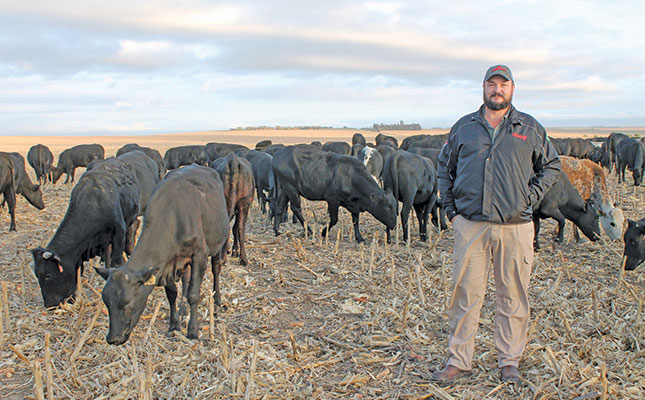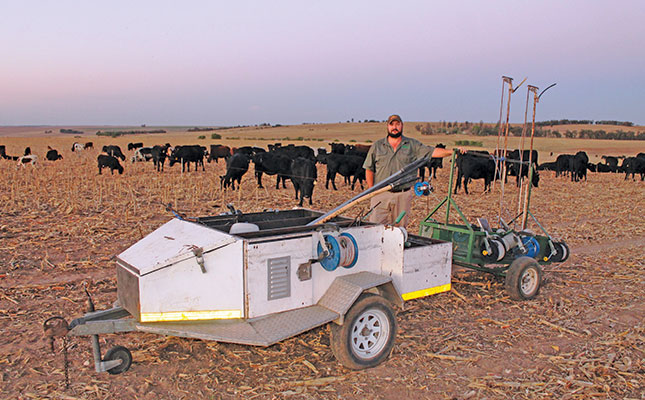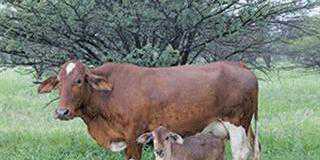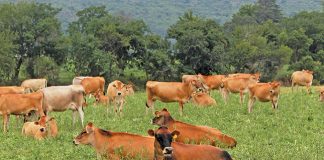
Photo: Lloyd Phillips
As the sun slowly rises over Van Rooyenswoning farm in the Reitz area of the eastern Free State, a 500- head herd of predominantly commercial Drakensberger beef cattle lines up expectantly along a 100m-long strand of portable electric fencing.
At exactly 6am, an automated system lifts the strand to above head height and, with excited bellowing and surprising bursts of speed, the cattle stream into the adjoining temporary grazing block to start grazing the maize crop residue.
This is a typical start to a day in Danie Slabbert’s ultra-high-density grazing (UHDG) system. He implemented it almost two years ago as an addition to his sustainable agriculture toolbox, which already comprised of no-till practices and planting multiple species of cover crops.
In addition to running cattle, Slabbert has a commercial cropping enterprise consisting of 1 000ha planted to grains and oilseeds, and 18ha to potatoes.
“I’m a fourth-generation Slabbert farmer, and beef cattle have always been on this farm. Before December 2017, they grazed extensively on 300ha of natural sourveld and on crop residues. But selective grazing of the veld resulted in a reduction of the cattle’s preferred grasses, such as red grass [Themeda triandra], and an increase in less preferred grasses, such as bushveld turpentine grass [Cymbopogon plurinodis],” he says.
Regeneration
In 2007, Slabbert made the decision to convert to regenerative agriculture, and began by adopting no-till cropping methods. When he reviewed his operation after five years, however, he realised that more needed to be done.
“My research and discussions with regenerative agriculture farmers and experts both in South Africa and internationally showed me that I needed to bring multi-species cover crops into rotation with my commercial crops.”
During his research, Slabbert also learned of the UHDG concept from his mentor, André Lund of Beaufort West, who advised him to read about the practical experiences of Zimbabwean cattle farmer Johann Zietsman regarding his own experiments with UHDG.
Mimicking the giant natural antelope herds
Quoting Zietsman, Slabbert says that UHDG with livestock mimics the actions and results of large herds of grazers in nature.
“For example, as many thousands of wildebeest migrate through Kenya’s Maasai Mara National Reserve, they graze everything in their path. Competition for forage between the animals is so high that they can’t afford to be selective of the grass species they eat. And the wildebeest soon move on, leaving the intensely grazed areas to recover for a year.

“This rapid and non-selective grazing stimulates the preferred grass species, and their diversity, to flourish to the detriment of less preferred grass species.”
In Slabbert’s UHDG system, all of the cattle are kept in a single large herd within a relatively small grazing camp.
The size of each grazing camp varies according to forage quantity and quality. The forage for Slabbert’s cattle comprises natural veld, mixed-species cover crops (see table), and crop residue.
Using a relatively simple, solar-powered set-up of portable electrified fencing, Slabbert and two of his experienced stockmen prepare the cattle’s grazing allocation for the current and following day.
The system comprises two strands of braided electric fencing for each length (strip). The strips, which are 100m apart, run parallel to each other for up to 1km.
Connecting the two strips is a single strand of electrified polywire, called a chop-line. This is used to control how far ahead the cattle may graze within the confines of the two strips. To achieve non-selective UHDG, the stockmen move the chop-line forward between 10m and 50m every hour, with the distance depending on how well the fodder has been utilised.
The chop-line is opened at 6am every morning and moved for the last time at 5pm. The strips should preferably not be more than 1km long.
“I don’t want the cattle to waste valuable energy and grazing time having to walk long distances between the farthest grazing block and the water. They spend the night in the area that has already been grazed.
“The water should always be at the start of the strip so that the cattle walk back over the area they’ve already grazed to get to the water,” Slabbert says.
He admits that he initially experienced challenges with UHDG. These included the change to the management routine on his farm, and having to train the cattle to respect the few and relatively flimsy electrified strands that are used to keep them confined within a given area.
Multiple benefits for the soil
In addition to stimulating non-selective grazing by the cattle, UHDG promotes the trampling of organic matter into the soil, and leaves a dense concentration of dung, urine and saliva behind. All of this, Slabbert explains, helps improve soil health, which, in turn, significantly reduces the risk of soil compaction caused by hoof action.
Another essential for successful UHDG is having a suitably long rest and recovery period for the grazed areas of natural veld.
“I allow my natural veld between 11 and 12 months to recover before it’s grazed again. I can do this because I have several species of cover crops, and the residue of my cash crops,” he says. “I’ve been using ultra-high-density grazing for only about two years, so I still have much to learn and refine in my system.”
In addition to the soil health and biodiversity benefits of UHDG, Slabbert has noted a number of other advantages. These include the opportunity to keep an eye on his cattle. It takes him mere minutes to walk through the herd and identify and immediately treat any health or other problem.
The animals become accustomed to human activities close to them and therefore stay calm, enabling Slabbert to approach a particular animal and inject it using an injection pole. Moreover, he and his stockmen come to learn the herd’s normal behaviour, which makes it easier to identify when the animals are agitated about something.
Quick set-up
According to Slabbert, setting up a day’s UHDG system in advance is fairly easy, and takes him or a stockman two hours. A stockman works permanently with the cattle and spends the rest of the day checking on them.
At two- to four-week intervals, depending on the quantity and quality of the fodder, Slabbert uses a GPS-guided tractor with a mower to slash visually identifiable paths for the location of the next two strips.
“It’s really satisfying to see all of my cattle with their heads down quietly grazing the fodder. I also love the fact that the health of the soil and veld is improving because of the UHDG system, and the cattle stay in good condition throughout the year without my having to make or buy in any feed,” he says.
He intends growing his beef herd to 1 000 breeding females by 2024, which he believes will be the optimal stocking rate for the farm’s UHDG system.
Email Danie Slabbert at [email protected].













